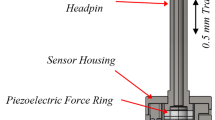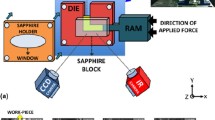Abstract
In this paper, in situ experiments have been designed using the full-field deformation technique of Digital Image Correlation (DIC) to characterize non-uniform shrinkage in thermoplastic polymers commonly used in traditional and emerging molding processes. These experiments are capable of characterizing the differences in strains that develop due to thermal gradients and stiction as the polymer shrinks from the molten to the solid state during molding processes. The experimental set-up consists of simulated open molds, a heating stage, thermocouples for temperature measurements, and a video imaging system for DIC. From these experiments, it has been shown that there is a large increase in shrinkage strain associated with the transition of the polymer from the molten to the solid state in a mold with reduced side rigidity, and as it is cooled below the Vicat softening point. Changing the cooling rate from air-cooled to quasi-steady state can eliminate the transition at the Vicat softening point. Furthermore, substantial decreases in shrinkage strain are observed when the polymer is melted in an open mold without mold release, while using mold release produces results similar to that observed with reduced side rigidity. A simple 1D model reasonably explains and predicts the observed trends in the shrinkage behavior due to temperature differences through the thickness of the polymer melt when using high conductivity molds as well as constraint in the polymer melt near the mold resulting from stiction.









Similar content being viewed by others
References
Ananthanarayanan A, Gupta SK, Bruck HA, Yu Z, Rajurkar KP (2007) Development of in-mold assembly process for realizing mesoscale revolute joints. North American Manufacturing Research Conference, Ann Arbor MI, USA, pp 1–8.
Banerjee A, Li X, Fowler G, Gupta SK (2007) Incorporating manufacturability considerations during design of injection molded multi-material objects. Res Eng Des 17:207–231.
Gouker RM, Gupta SK, Bruck HA, Holzschuh T (2006) Manufacturing of multi-material compliant mechanisms using multi-material molding. Int J Adv Manuf Technol 28:1–27.
Priyadarshi AK, Gupta SK, Gouker R, Krebs F, Shroeder M, Warth S (2007) Manufacturing multi-material articulated plastic products using in-mold assembly. Int J Adv Manuf Technol 32:350–365.
Ananthanarayanan A., Thamire C, Gupta SK (2007) Investigation of revolute joint clearances created by in-mold assembly process. IEEE International Symposium on Assembly and Manufacturing, Ann Arbor, Michigan, pp 26–134.
Bushko WC, Vijay K (1996) Stokes solidification of thermoviscoelastic melts. Part 4: Effects of boundary conditions on shrinkage and residual stresses. Polym Eng Sci 36:658–675.
Titomanlio G, Jansen KMB (1996) In-mold shrinkage and stress prediction in injection molding. Polym Eng Sci 38:2041–2049.
Jansen KMB, Titomanlio G (1996) Effect of pressure history on shrinkage and residual stresses-injection molding with constrained shrinkage. Polym Eng Sci 36:1537–1550.
Jansen KMB, Van Dijk DJ, Husselman MH (1998) Effect of processing conditions on shrinkage in injection molding. Polym Eng Sci 38:838–846.
Kramschuster A, Cavitt R, Ermer D, Chen Z, Turng L-S (2005) Quantitative study of shrinkage and warpage behavior for microcellular and conventional injection molding. Polym Eng Sci 45:1408–1418.
Liao SJ, Chang DY, Chen HJ, Tsou LS, Ho JR, Yau HT, Hsieh WH (2004) Optimal process conditions of shrinkage and warpage of thin-wall parts. Polym Eng Sci 44:917–928.
Pontes AJ, Pouzada AS (2004) Ejection force in tubular injection moldings. Part I: Effect of processing conditions. Polym Eng Sci 44:891–898.
Han S, Wang KK (1997) Shrinkage prediction for slowly crystallizing thermoplastic polymers in injection molding. Int Polym Process, XII, 12:228–237.
Delaunay D, Le Bot P (2000) Nature of contact between polymer and mold in injection molding. Part II: Influence of mold deflection on pressure history and shrinkage. Polym Eng Sci 40:1682–1691.
Kwon K, Isayev AI, Kim KH (2005) Toward a viscoelastic modeling of anisotropic shrinkage in injection molding of amorphous polymers. J App Polym Sci 98:2300–2313.
Bruck HA, Fowler G, Gupta SK, Valentine T (2004) Using geometric complexity to enhance the interfacial strength of heterogeneous structures fabricated in a multi-stage, multi-piece molding process. Exp Mech 44:261–271.
Egan E, Amon CH (2000) Thermal management strategies for embedded electronic components of wearable computers. J Electron Packag 122:98–106.
Goodship V, Love JC (2002) Multi-material injection molding. ChemTec Publishing, Toronto.
The NJ, Conway PP, Palmer PJ, Prosser S, Kioul A (2000) Statistical optimisation of thermoplastic injection moulding process for the encapsulation of electronic subassembly. J Electron Manuf 10:171–179.
Sarvar F, Teh NJ, Whalley DC, Hunt DC, Palmer DA, Wolfson PJ (2004) Thermo-mechanical modelling of polymer encapsulated electronics. IEEE Intersociety Conference on Thermal Phenomena. Las Vegas, NV 2:465–472.
Bruck HA, Schreier HW, Sutton MA, Chao YJ (1997) Development of a Measurement System for Combined Temperature and Strain Measurements During Welding,” Technology Advancements and New Industrial Applications in Welding, pp. 523–526.
Bruck HA, McNeill SR, Sutton MA, Peters WH III (1989) Digital image correlation using Newton-Raphson method of partial differential correction. Exp Mech 29:261–267.
Sutton MA, Turner JL, Bruck HA, Chae TL (1991) Full-field representation of discretely sampled surface deformation for displacement and strain analysis. Exp Mech 31:168–177.
Helm JD, McNeill SR, Sutton MA (1996) Improved three-dimensional image correlation for surface displacement measurement and strain analysis. Opt Eng 35:1911–1920.
Luo PF, Chao YJ, Sutton MA, Peters WH III (1993) Accurate measurement of three-dimensional deformations in deformable and rigid bodies using computer vision. Exp Mech 33:123–132.
Schreier HW, Braasch JR, Sutton MA (2000) Systematic errors in digital image correlation caused by intensity interpolation. Opt Eng 39:2915–2921.
Acknowledgements
This work was supported by NSF grants EEC0315425 and DMI0457058, and by ONR award number N000140710391. Opinions expressed in this paper are those of the authors and do not necessarily reflect opinions of the sponsors.
Author information
Authors and Affiliations
Corresponding author
Rights and permissions
About this article
Cite this article
Gershon, A.L., Gyger, L.S., Bruck, H.A. et al. Thermoplastic Polymer Shrinkage in Emerging Molding Processes. Exp Mech 48, 789–798 (2008). https://doi.org/10.1007/s11340-008-9136-2
Received:
Accepted:
Published:
Issue Date:
DOI: https://doi.org/10.1007/s11340-008-9136-2




